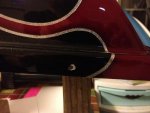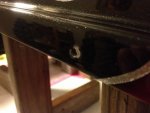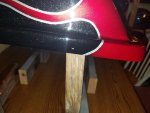So I ran into a little problem last night on final assembly. One of the rivets pulled the pin all the way through instead of popping off. Enlarged the hole from a tight 1/8 to maybe 5/32 to 3/16 and deformed the surface a bit right around the hole. Then I totally screwed the paint when I SOOOOO carefully pushed the rivet out. Blew out a good chunk all the way down to the glass. Rivet head only covers half the damage. So whatever I do the repair will be visible all the way around the rivet.
How do I go about fixing this. JB weld? Fiberglass resin? Just layer epoxy primer until the build is the same level as the rest?
I have half a mind to fill the entire hole with JB weld and then float a toothpick off in the center of the hole (for the drill bit to follow later). Drill the new hole, carefully sand flat and feather out a little, spray a little black epoxy with the airbrush, sand and feather just a tad, light coat of black BC with the airbrush, couple of coats of clear with the airbrush, then cut with 1200/2000 and buff by hand.


How do I go about fixing this. JB weld? Fiberglass resin? Just layer epoxy primer until the build is the same level as the rest?
I have half a mind to fill the entire hole with JB weld and then float a toothpick off in the center of the hole (for the drill bit to follow later). Drill the new hole, carefully sand flat and feather out a little, spray a little black epoxy with the airbrush, sand and feather just a tad, light coat of black BC with the airbrush, couple of coats of clear with the airbrush, then cut with 1200/2000 and buff by hand.



